Women’s Robe
A few months ago, when I made the Kid’s Robe, the response was unanimous: “One in my size too, please!” We couldn’t have agreed more! So, thanks to your great advice, we introduce… the Purl Soho Women’s Robe!
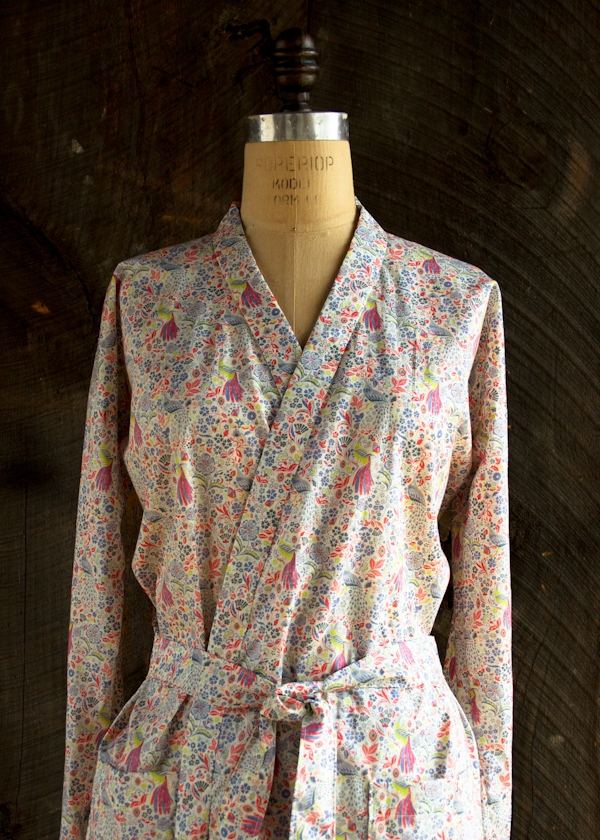
I knew immediately that I was going to like this project, but once I started, I fell in actual love. I didn’t know my life was missing this robe, but then, I couldn’t believe I had gone so long without one. I began to keep a mental tally of all the people who would be getting a handmade robe from me (first on the list: happy Mother’s Day, mom!).

I designed the Purl Soho Women’s Robe to be roomy but not bulky, classic but not prim, comfy but not sloppy. Although you can make yours in any light or mid-weight cotton, linen or flannel, I love the breezy look and feel of Liberty of London’s gorgeous Tana Lawn. I used the Seasonal print Junos Garden Pastel.

The Purl Soho Women’s Robe Pattern walks you through every step of the process with detailed photographs and tons of helpful tips. It includes sizes from Extra Small to Extra Large, in both above-the-knee and below-the-knee lengths. Pick up a copy of the PDF right here!
Thank you, dear readers, for inspiring me to make this wholly satisfying robe. And keep those suggestions coming! -Corinne
Materials
- Lightweight Cotton, Medium Weight Cotton, Flannel or Linen Fabric. We used Liberty of London’s Seasonal print Junos Garden Pastel. See chart (below) for quantities.
- One 274-yard spool of Gutermann’s Cotton Sewing Thread, color 1040
- The Purl Soho Women’s Robe Pattern is no longer available for purchase. For assistance, please contact us at customerservice@purlsoho.com.
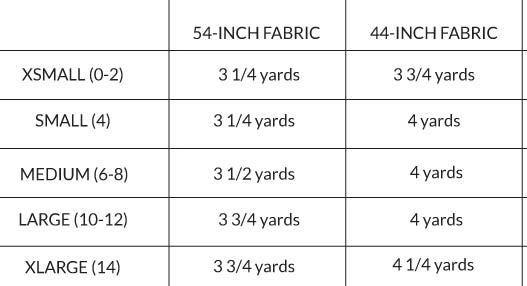
Update: New Fabric
September 18, 2014
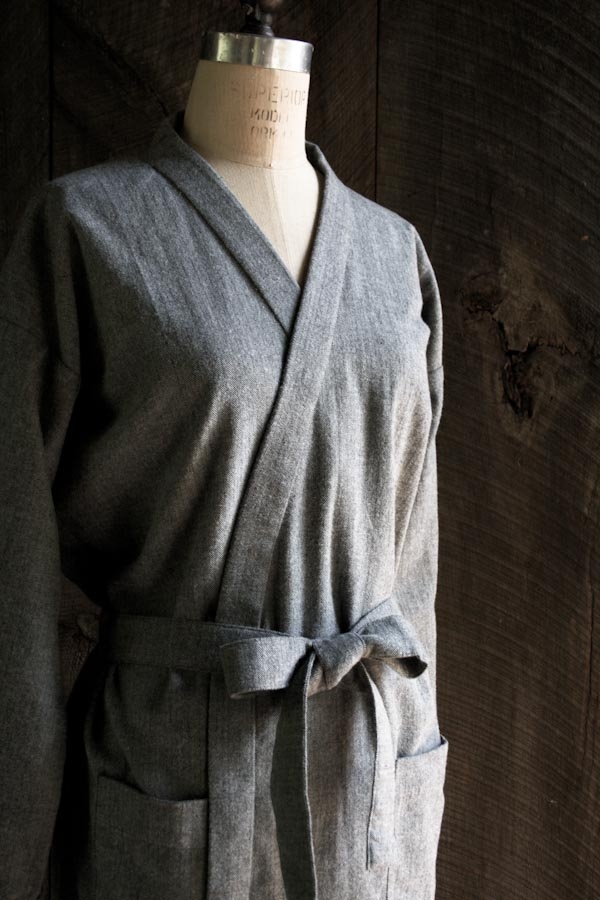
And what about when the chilly winds start to blow? Check out our cold-weather version, the Purl Soho Women’s Robe in Cozy Flannel! Click right here to read all about it.
Update: New Fabric + Bias Details
June 13, 2016
We’ve made our classic Women’s Robe in Purl Soho’s lovely Linen Grid and added a few twists and turns along the way! To see this handsome new garment with new bias details, check out our Women’s Robe in Linen Grid story!
Sizes
XSmall (Small, Medium, Large, XLarge)
Pattern
The Women’s Robe Downloadable Pattern is available for purchase as a PDF download.
Update: Adding Room to the Sleeve and Shoulder Seam
June 30, 2016
Some of our readers (but not all!) have found that the Sleeve and Shoulder seams of this Robe can feel a little tight, particularly when working with heavier weight fabrics. If you’re worried that the Sleeves might be too tight for you, please follow these suggestions!
If you haven’t yet cut out your fabric pieces…
We suggest adding 1 ½ to 2 inches to the Shoulder Edge of the Sleeves (this is the shorter side of the Sleeve rectangle). You will also need to increase the size of the Sleeve Binding by the same amount. Follow the cutting chart to cut out the remaining pieces in your size and follow the pattern as printed.
If you’ve finished your Robe and find that the Sleeves are too tight…
You can extend the width in the underarm by adding a Gusset. Here’s how…

Cut two diamond shapes from your fabric, 6 inches tall and 3 inches wide. These are the Gusset pieces.
Using a fabric marker, on the wrong side of each Gusset draw lines ¼ inch from and parallel to each edge. Make sure that the points where these lines intersect are clear. These are the Corners.

Rip out one underarm seam of the Robe, 2 ½ inches along the Sleeve and 2 ½ inches along the side seam.

With right sides facing each other, sew the Gusset into the underarm of the Robe. Here’s how …
Orient the Gusset so that the long axis runs from the Sleeve seam to the side seam. Pin one edge of the Gusset to one raw edge of the Sleeve. The top Corner of the Gusset should meet the Sleeve seam, and one side Corner of the Gusset should meet the right angle of the underarm.
Set your machine with a short stitch length and sew along the pinned line with a ¼-inch seam allowance, using the marked line as your guide. Start and stop the seam at the marked Corners.

Now, pin the Gusset to one raw edge of the Robe’s side. The bottom Corner of the Gusset should meet the side seam of the Robe.
Sew along the pinned line as described above.

Repeat with the remaining two sides of the Gusset.
Sew along all raw edges of the seam allowances with a zigzag stitch.

The Gusset is complete, and you have a roomier Robe!
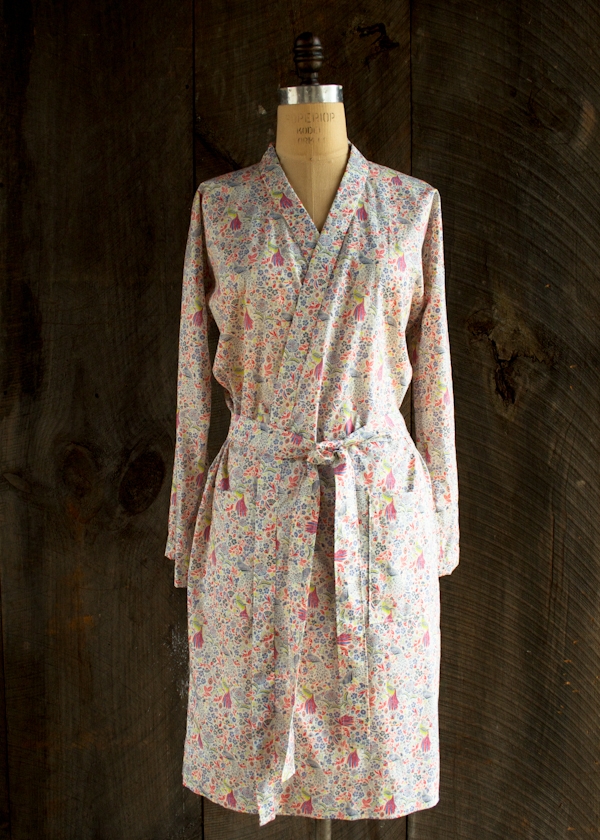

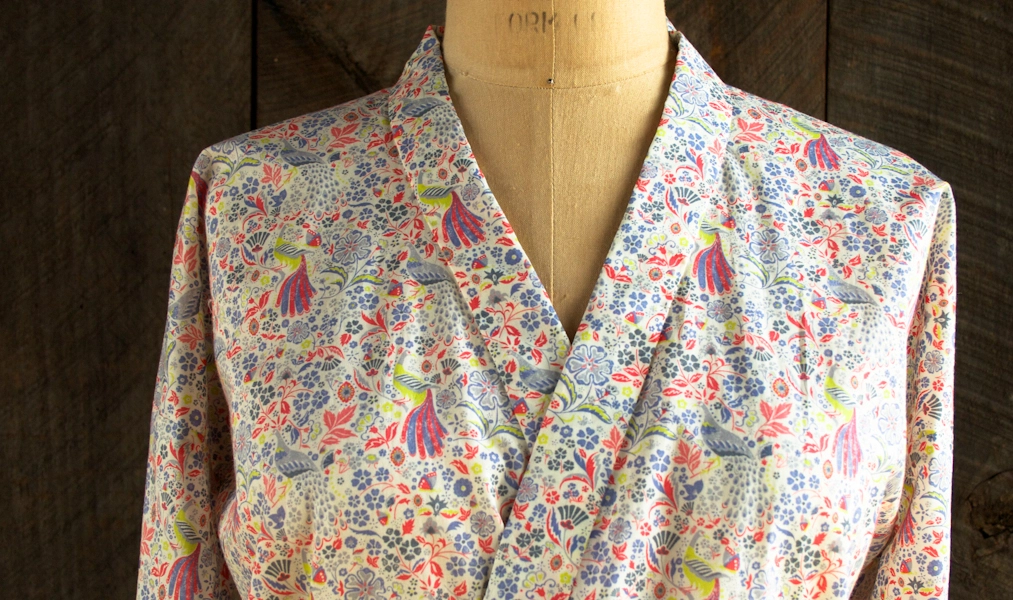
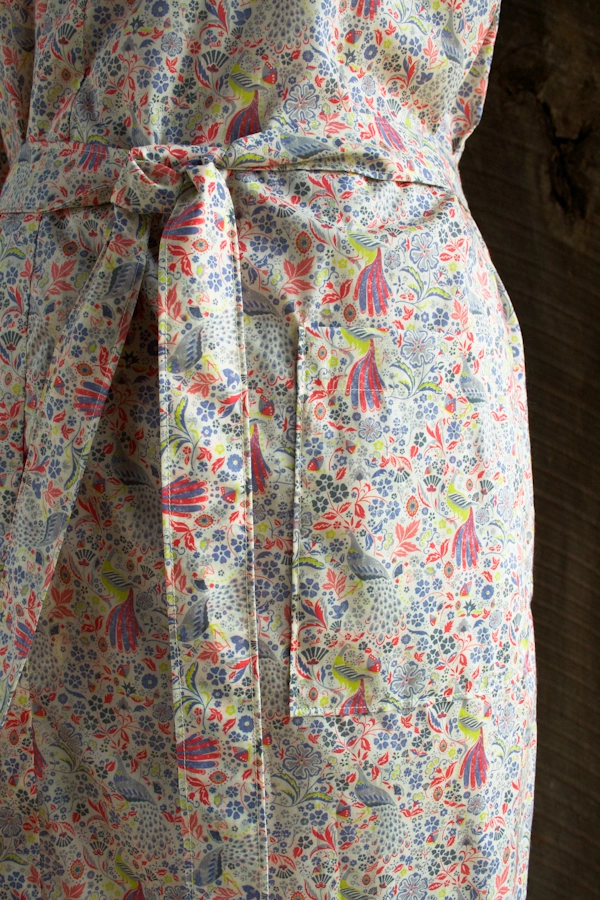
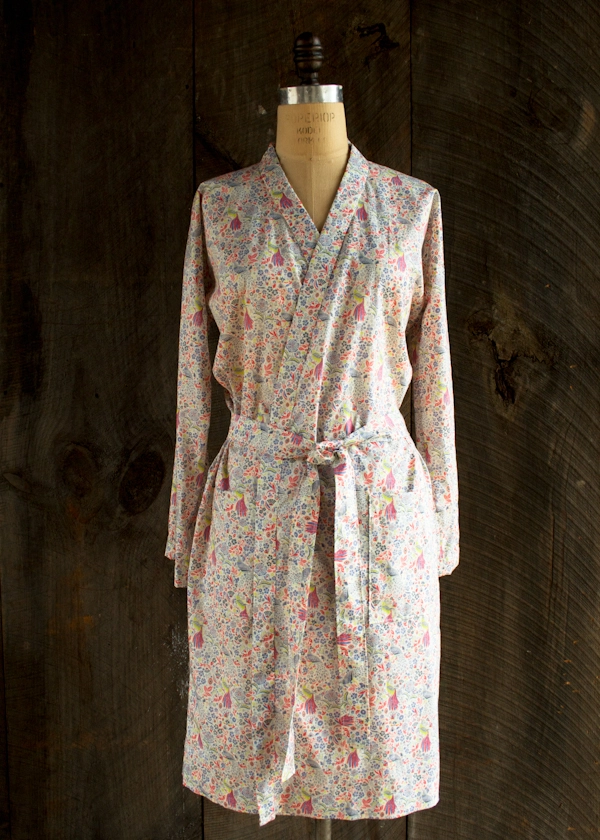
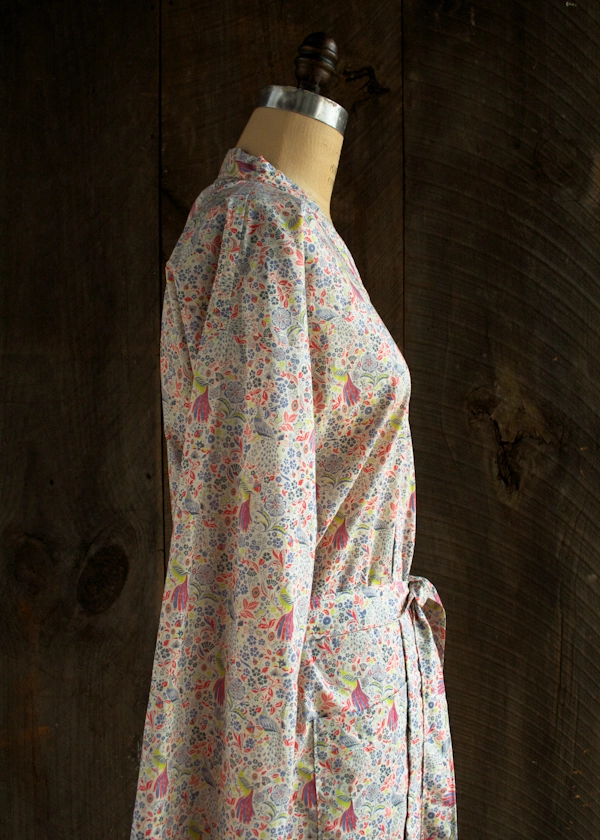
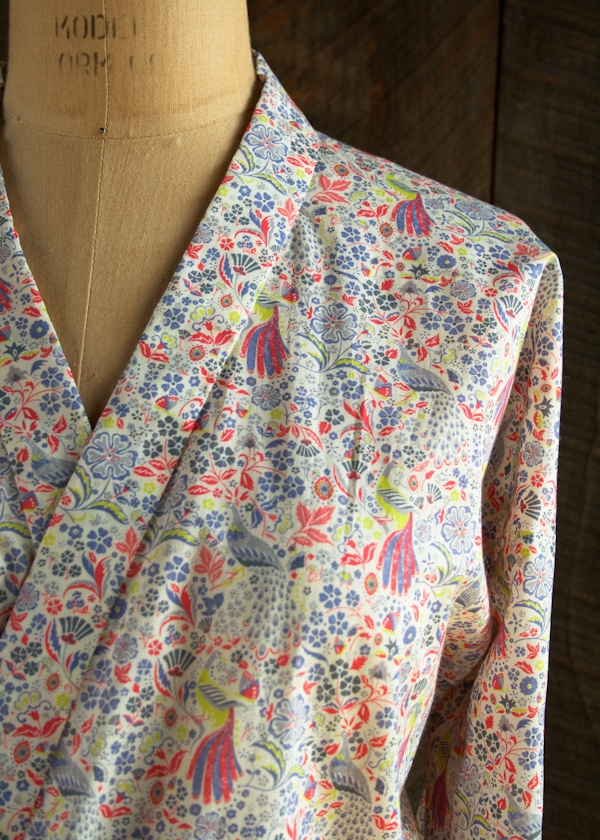
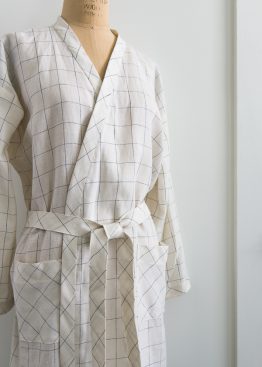

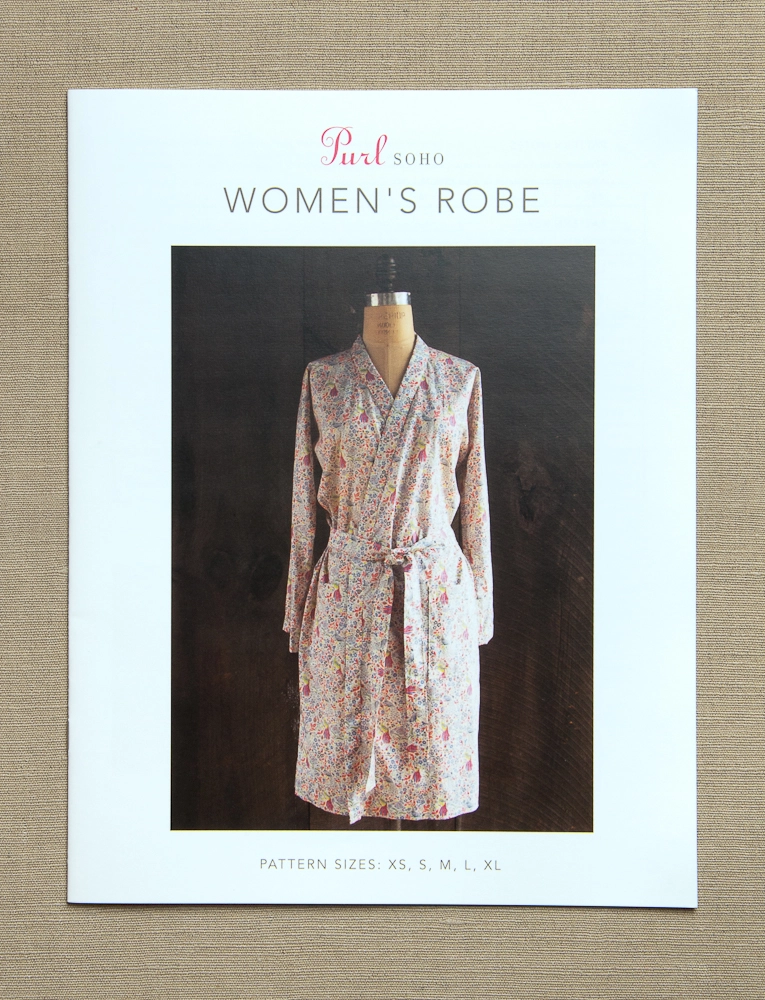


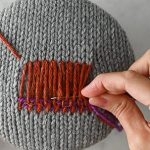

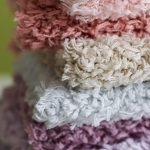

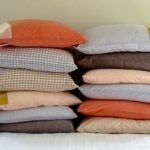
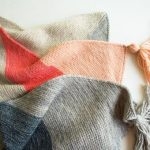
Does the pattern include seam allowance?
Hi and thanks for reaching out! Yes, all of our patterns include a seam allowance so you don’t need to add one!
Best,
Julianna
Hi
I just bought your robe pattern and downloaded it. Where is the actual pattern? I assumed that I could print out the pattern pieces and use them like regular paper pattern for this robe?
Thank you for your help.
Kate
Hi Kate,
Thanks for reaching out! Because this robe is comprised entirely of simple rectangles, there are no pattern pieces to print. You can find a cutting chart on page 3 that will tell you the dimensions of each rectangle, as well as a cutting layout on page 2. When cutting out patterns like this, I find it very helpful (and fast!) to use a ruler and chalk to mark out each piece before cutting.
I hope that clears things up!
Julianna
Could you please explain your comment about “adding 1 1/2 to 2 inches to the shoulder edge”? Are you saying that if you want to make the sleeve less tight that one should cut the sleeve 1 1/2 to 2 inches longer? Or cut it 1 1/2 to 2 inches wider. In other words, for medium, the pattern calls for the sleeve to be cut 16 x 19 1/2. Should I cut it 18 x 19 1/2? Or 16 x 21 1/2? Thanks!
Hi Bobbi,
Thanks for reaching out, and I apologize for the confusion! To make the shoulder a little looser, you should cut the sleeve wider, not longer, so your adjusted sleeve will measure 18 by 19.5.
I hope that clears things up!
Julianna
Thanks for your help. Instead of cutting the sleeve piece as a rectangle measuring 16 1/2 x 19 3/4, I cut the sleeve piece as an isosceles trapezoid measuring 22 inches (the shoulder seam), 17 inches (lower arm width), and 19 3/4 inches long from the shoulder seam to the lower arm.
I also made the following changes:
1. I lined with heavy (12 oz) terry cloth. Because of this, and using a previous suggestion, I increased the size I wanted by one (from medium to large).
2. I cut the pockets 9 1/2 x 9 1/2. The given measurement was a little narrow.
3. I made and attached belt loops (similar to the hanging loop) instead of attaching the belt to the robe.
4. Because I lined the robe, I did not put a binding on the sleeves, but instead turned the two cloths toward each other and top stitched. I also did the same on the hem.
I love how this robe turned out. It’s a little heavy with the terry cloth lining, but should be great for cold weather! Thanks Purl Soho
Hi Bobbi,
Thank you so much for sharing your wonderful modifications and tips – this sounds like a wonderfully cozy version of our robe! I’m all this extra information you have so kindly provided will help many other sewists customize their projects!
All the best,
Julianna
I notice you are using French Seams for the shoulder and sleeve seams. Is it not possible to use French Seams for the Side Seams, too?
Hi Diane,
Thanks for reaching out! Since the shoulder seams are sewn first and then the side seams (the underarm seam and side seam) are sewn after, because of this it would be pretty difficult to use a french seam, especially at the underarm point! This is why we use a different method for these seams rather than french seams.
I hope this clears things up!
Gianna
I’ve made this robe three times. I first made it lined with terry cloth. I then made it twice using Liberty of London Tana fabric, without a lining. These two unlined robes are gorgeous and look like they could be sold at high end boutiques! I highly recommend this pattern. THANK YOU PURL SOHO!! The robe is simple, but beautiful in it’s details. The trim band on on the sleeves and around the front and neck, and the enclosed seams give the finished robe a very professional look. I wanted to share a few changes that I made on the two unlined robes which I just completed. I was writing them down for myself and thought I should share them.
1. SLEEVES: In previous comments by Purl Soho, it was suggested to widen the sleeves by 2 inches, or (if you’ve already cut and sewn the sleeves) remove the sleeves and add a gusset. This is what I did:
I added 2 inches to width of the sleeves PLUS I added a right triangle to the top of each sleeve. This gives more room to the arm pit or underarm area. Here’s an explanation of the sleeve pattern I used:
Start with the sleeve measurement for your size. I’ll use size M as an example. The pattern gives a measurement 16 x 19 1/2 inches. Instead start with a rectangle measuring 18 x 19 1/2 inches. At the top edge, the 18 inch edge, extend the width 2 inches on each side (now 22 inches). Then make a mark on the original pattern 5 inches down on each side. Connect the extended 2 inch mark with this 5 inch mark. This will add a right triangle (pointing down) at the top of each side of the sleeve. This gives the wearer more ease in movement in that area.
Also, I chose to line the bottom part of the sleeve. This was easy. I just cut the sleeve 9 inches longer. After the sleeve seam is sewn, just turn this 9 inches inside, fold the edge in 1/2 inch, and hand or machine stitch in place. Note: I still added the sleeve binding because it gives the robe such a professional look.
2. SLEEVES: After following all of the instructions on page 6 for sewing the sleeve pieces on to the body, I repeated steps 8 and 9 for the shoulders (on page 5): Press the seam toward the sleeve and “Sew the seam down with an edge stitch”.
3. SIDESEAMS: I loved that the shoulder seam and the seam attaching the sleeve to the body were enclosed. In a previous comment, someone asked why this wasn’t done with the seam that runs along the sleeve and body side seam. It can’t be done along the entire seam, but it can be done along just the (body) side seam. And this gives a much more “finished” and professional look. Here’s how I did it:
1) Sew just the side seam, following steps 1,2,3 and 5 from the shoulder seam instructions on page 5.
2) With right sides together, sew the sleeve seam. Reinforce the turn where the sleeve meets the side seam by back stitching at this corner.
3) Cut a small diagonal slit into the underarm as instructed in step 4 of the side seam instructions on page 7.
4) Zigzag the sleeve seam, going over the diagonal cut area (to give it added reinforcement).
5). Now complete steps 8 and 9 from the shoulder seam instruction on page 5.
4. POCKETS: The pockets are too narrow. I widened them and I also chose to double the fabric. This is what I suggest:
1) Cut the fabric 19 x 9 1/2 inches.
2) Fold, right sides together, and sew the 3 raw edges, leaving a 2 inch opening to turn.
3) Turn, push corners out, press.
4) Sew a top stitch 3/4 inch down from folded edge. I sewed a second stitch (because I think it gives a nice look) 1/4 inch from the first topstitch.
5) Sew in place (as instructed in the pattern on page 14). After the edge stitch, I added a second finishing stitch 1/4 “ from the edge stitch.
5. I choose to not attach the belt, but to make belt loops instead. Here’s what I did:
1) Cut two pieces of fabric 2 x 5 1/2 inches.
2) Use the instructions for the Hanging Loop on page 9, except, fold in the ends before step 5. Then edge stitch around the edge and one more time down the center. (This gives it more “body”. )
3. Attach to the side seams. I made a mark 4 1/2 inches above the line of the pocket. I turned the belt loop up-side-down and attached the top of the belt loop at the mark on the side seam by sewing about 1/4 inch in from its end. Be sure to reinforce by backstitching. I then placed the bottom of the belt loop in place, turned it under about 1/4 inch and sewed in place on the side seam. (You can do this by carefully pushing the top of the belt loop out of the way and placing the machine foot under the belt loop.)
AS AN ADDED EXTRA, and because I had some extra fabric, I made two terry-lined wash clothes to go with each robe. I used the Purl Soho “Hooded Baby Towel and Washcloth Set.” The pattern and instructions are on their site. These made the gifts complete!
Thanks again PURL SOHO for the wonderful patterns and material!
I think that the measurements for cutting the neckline width are backwards for changing sizes. I have made the robe but the neckline doesn’t hug my neck as closely as I’d like. In planning to make another one with a better fitting neckline, I see that to make a smaller size, (where the neck would presumably fit a smaller person) the measurements from the top outside (shoulder) corner of the robe front to the center front get smaller (making the opening wider). This seems to be an error, or am I misinterpreting it? Thank you.
Hi Sally,
Thank you for your question! We took a look at the pattern and weren’t able to find any errors but wanted to clarify that the shoulder section of this robe adjusts proportionately with the neckline as you go up in size. Looking at the bottom of page 3 in this pattern, the fabric piece showing where to cut from point A and B is where you would adjust to make this fit more closely by moving the position of Point A closer to the right edge of the front piece. Keep in mind you may have to adjust the binding a little longer to account for this change!
If you would like more help visualizing this, feel free to reach out to us at customerservice@purlsoho.com where we would be happy to provide you with a diagram demonstrating how to do this!
Hope this helps!
Best,
Margaret
I am getting ready to cut out my pieces for this robe and am curious as to whether the fabric is laying out open or folded in half?
Hello!
Thanks for reaching out to us! The template pieces for this pattern should be cut from fabric that is laying open. There is also a diagram on page 2 of the pattern that includes 2 layout options for how to arrange the pattern pieces before cutting!
I hope this helps! Please let us know if you have any questions.
All the best,
Carly
Hello! Not an experienced sewer and am confused about how to increase the sleeve binding. I cut the sleeves to a trapezoid per another commenter (16 1/2 by 19 3/4 by 22). How now to cut the sleeve binding? 7 by 16 1/2, or 5 by 22?
Thanks!
Hi Jenny,
Thanks for writing in! We compared the numbers you had and the pattern as written and think you shouldn’t have to increase the binding at all.
You mentioned cutting a trapezoid. Can you confirm if the dimensions are 16½ (lower arm width) by 19 3/4 (length) by 22 (shoulder seam)? The binding relates to the lower arm width so it shouldn’t change. That’s why we think you’re good to move ahead as is!
Please let us know if we’re misunderstanding the question though. We’re happy to take another look if needed!
All the best,
Zha Zha